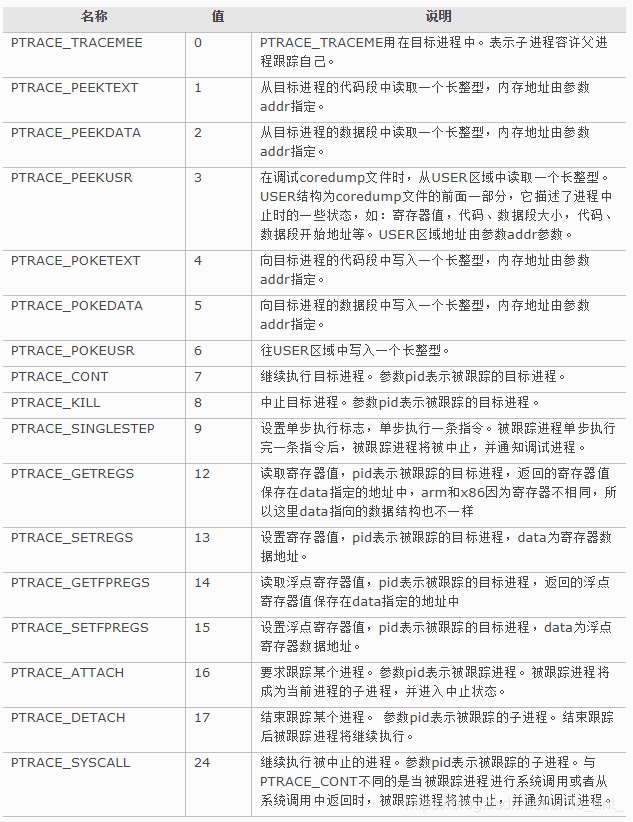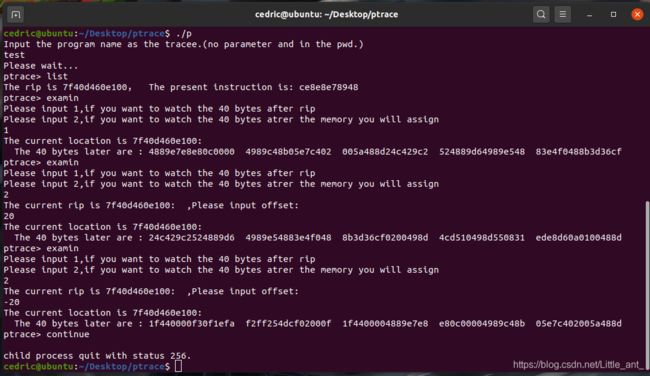linux(4)-Ptrace 系统调用的使用
文章目录
-
- 问题
- 运行环境
- 程序组成
- 实现思路
- 模块划分
- 完整代码
- 程序运行及结果
问题
利用ptrace系统调用实现一个简单的软件调试器。基本功能包括能够截获被调试进程的信号,被调试进程进入断点后能够查看被调试进程任意内存区域的内容,能够查看任意CPU寄存器的内容,能够使被调试进程恢复运行。
运行环境
Ubuntu-20.04 64位虚拟机
程序组成
1,测试程序为test.c,这是后面要被测试的程序;它的可执行程序为test(采用-g进行编译)。
2,Ptrace系统调用的实现程序为ptrace.c。
实现思路
查看阅读ptrace官方文档(man ptrace),从文档的相关说明中有了大体的实现思路,摘自手册:
A process can initiate a trace by calling fork and having the resulting child do a PTRACE_TRACEME, followed (typically) by an execve,Alternatively, one process may commence tracing another process using PTRACE_ATTACH or PTRACE_SEIZE.
其中第一种是被动的,让别人来调试自己;第二种是主动去调试别人。后面采用第一种方法。
Ptrace的函数原型为:
#include
long ptrace(enum __ptrace_request request, pid_t pid, void *addr, void *data);
参数request:请求ptrace执行的操作;参数pid:目标进程的ID;参数addr:目标进程的地址值;参数data:作用则根据request的不同而变化,如果需要向目标进程中写入数据,data存放的是需要写入的数据;如果从目标进程中读数据,data将存放返回的数据。如下图:

需注意:当采用参数request为PTRACE_PEEKTEXT时,代码段中的数据被保存在返回值中。返回值为一个long类型。(经测试long和long long在当前环境上均为8字节长)
在子进程中采用ptrace(PTRACE_TRACEME,0,0,0),来让父进程来调试它,这个方法的执行应该在exec()函数执行前,来保证执行exec()时,子进程已经处于被调试状态。
采用fork(),将父进程作为tracer,将子进程作为tracee;再通过exec ()函数族将待调试的程序装入到子进程中,并且exec()函数族在执行时若发现原进程处于调试状态下的话,当将新的代码装入后,会向自身发送信号SIGTRAP,中止执行,方便在父进程中来进行操作。
父进程中通过简单的循环操作来接受用户的输入,对不同的输入进行不同的操作。所接受的用户指令有:退出(exit),查看大部分寄存器内容(regs),继续执行被调试进程(continue),列出子进程代码,查看特定内存处的内容(examin),添加断点,查看一共有多少条指令(insc),单步调试(step),列出当前rip指向的指令(list)。
模块划分
1,获取用户输入的待调试程序,(这里输入的程序要求:不能带有参数,单线程,且需要在当前目录下)
2,fork出一个子进程,采用execvp函数来装入待调试程序。
3,父进程实现具体的操作来对子进程进行调试工作。
完整代码
ptrace.c:
#includetest.c:
#include程序运行及结果
1,编译两个.c文件:gcc –o p ptrace.c gcc –g test.c –o test
2,最终,父进程支持的命令操作如下:
a, exit 终止被调试程序(子进程),并且父进程退出
b, continue 恢复子进程的执行, 父进程稍后退出
c, regs 查看当前子进程的寄存器内容(很少用到的就不列出了)
d, list 显示当前rip的内容,以及需要待执行的指令(更好的说法应该是:rip指向的内存处的8B长度的值)。
e, step 单步执行
f, examin 查看当前rip所指向的内存后面40B长的内容。按照字节来显示。
g, insc 查看子进程需要单步执行的步数。
3,查看寄存器rip所指向地址后40个字节的内容。 命令 examin 后输入 1 即可。
查看指定内存处内容,内存地址不好输入,在此选择相对于rip的偏移来间接查看任意内存处的值。 命令 examin 后, 输入 2 ,输入相对于rip的偏移地址,
比如:下面分别输入+20 和 -20,内存处的内容如下图所示。并且通过 命令 continue 让被调试程序继续执行。此时退出状态为0



